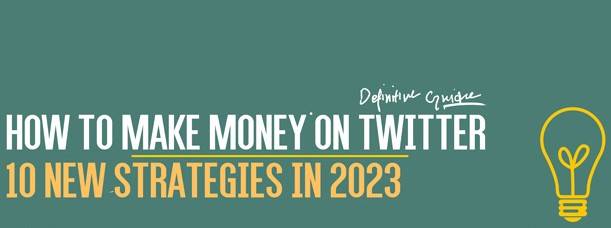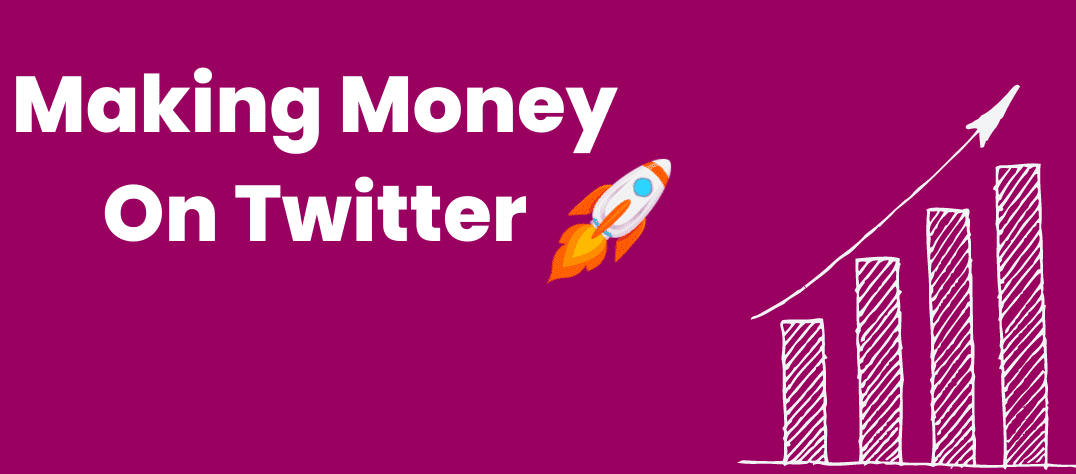how to make money on Twitter in 2023 with these 15 proven tactics. Build a strong Twitter presence, create engaging content, and earn through affiliate marketing and sponsored tweets.

Are you looking for ways to monetize your Twitter account and turn your tweets into cash? With over 330 million monthly active users, Twitter is one of the most popular social media platforms in the world. In this article, we will show you 15 proven tactics for making money on Twitter in 2023.
Introduction: The Power of Twitter for Earning Money
Twitter is a powerful tool for making money online. Whether you’re a blogger, a business owner, or an influencer, Twitter offers many opportunities to earn revenue. With its massive user base, Twitter provides a platform for businesses to promote their products and services and for individuals to reach a large audience.
Build Your Twitter Following: Strategies for Increasing Your Reach
To make money on Twitter, you need to have a large and engaged following. Building your Twitter following takes time and effort, but it’s worth it in the long run. In this section, we’ll discuss some strategies for increasing your reach on Twitter, including optimizing your profile, creating high-quality content, and engaging with your followers.
Optimize Your Profile
Your Twitter profile is the first thing people see when they visit your page. Make sure your profile is optimized to attract new followers. Use a high-quality profile picture and header image, write a compelling bio, and include relevant keywords.
Create High-Quality Content
To attract and retain followers, you need to create high-quality content that engages and entertains your audience. Use a mix of text, images, and videos to keep your followers interested.
Engage with Your Followers
Engaging with your followers is essential for building a loyal fan base. Respond to comments and messages, ask questions, and run polls to encourage interaction.

Create Engaging Content: How to Keep Your Followers Interested
Creating engaging content is key to building a loyal following on Twitter. In this section, we’ll share some tips for creating content that resonates with your audience and keeps them coming back for more.
Use Eye-Catching Visuals
Visual content is more engaging than text-only posts. Use high-quality images and videos to grab your followers’ attention and make your tweets stand out.
Be Timely and Relevant
Stay up-to-date with the latest trends and news in your niche. Tweet about trending topics and events to keep your followers engaged.
Use Humor and Personality
Twitter is a social platform, so don’t be afraid to inject some humor and personality into your tweets. People love to follow accounts that make them laugh and feel good.
Affiliate Marketing: How to Promote Products and Earn Commissions
Affiliate marketing is a popular way to make money on Twitter. In this section, we’ll explain how affiliate marketing works and share some tips for promoting products on Twitter.
What is Affiliate Marketing?
Affiliate marketing is a type of marketing where you promote other people’s products and earn a commission for every sale made through your unique affiliate link.
Choose the Right Products
To be successful with affiliate marketing, you need to choose products that are relevant to your audience and align with your brand.
Use Compelling Calls-to-Action
Include a strong call-to-action in your tweets to encourage your followers to click on your affiliate links and make a purchase.

Sponsored Tweets: How to Get Paid for Promoting Brands
Twitter is not just a platform for socializing and networking but also an excellent place for making money. With the right strategies and techniques, anyone can leverage Twitter to make a living by promoting brands and products. In this article, we’ll cover the following topics to help you get started:
What Are Sponsored Tweets?
Before we dive into the specifics, let’s define what sponsored tweets are. A sponsored tweet is a post that a Twitter user creates to promote a product or service, in exchange for payment from the brand or advertiser.
How to Get Started with Sponsored Tweets?
Getting started with sponsored tweets is relatively easy. All you need is a Twitter account with a considerable number of followers, and you’re good to go. Here’s how to get started:
Build a Strong Twitter Presence
Before brands can start reaching out to you for sponsored tweets, you need to build a strong Twitter presence. You can achieve this by regularly posting high-quality content that engages your followers and attracts new ones.
Join Twitter Influencer Platforms
Several Twitter influencer platforms connect brands with influencers for sponsored tweets. These platforms have different requirements, but most of them require influencers to have a certain number of followers and high engagement rates.
Reach Out to Brands Directly
If you have a specific brand in mind that you want to work with, you can reach out to them directly. Ensure that your pitch is professional and outlines your experience and what you bring to the table.

How to Price Your Sponsored Tweets?
Pricing your sponsored tweets can be a bit challenging, especially if you’re just starting. Here are some factors to consider when setting your rates:
Number of Followers
The higher your number of followers, the more you can charge for your sponsored tweets.
Engagement Rates
Brands are more likely to work with influencers with high engagement rates. Therefore, if you have high engagement rates, you can charge more for your sponsored tweets.
Industry
Different industries have different rates for sponsored tweets. For instance, the rates for a tech-related tweet may differ from those of a fashion-related tweet.

How to Ensure Success with Sponsored Tweets?
Success with sponsored tweets doesn’t come overnight. Here are some tips to help you succeed:
Be Authentic
Your followers will appreciate authenticity, so ensure that you only promote products that align with your brand and values.
Disclose Your Partnerships
Disclose your partnerships with brands to maintain transparency and trust with your followers.
Monitor Your Performance
Regularly monitor your sponsored tweets’ performance to ensure that they’re delivering results for the brand and your followers.

Sell Your Own Products: Tips for Marketing and Selling on Twitter
Twitter is one of the most effective platforms to sell products and connect with potential customers. Whether you’re a small business owner or an individual entrepreneur, Twitter provides a great opportunity to market and sell your products. In this article, we will discuss some tips for marketing and selling your own products on Twitter.
Setting up your Twitter Account
Before you start marketing your products on Twitter, you need to set up your Twitter account in the right way. Here are some tips to follow:
Optimize your Twitter Profile
Your Twitter profile is the first thing people see when they visit your page. It’s essential to make a good impression by optimizing your profile. Make sure to include a clear profile picture, a cover photo, and a short bio that explains what you do and what you offer.
Use Relevant Hashtags
Hashtags help your tweets to reach a larger audience. Make sure to use relevant hashtags that are related to your products. You can also use popular hashtags to gain more exposure.
Engage with your Audience
Engaging with your audience is crucial to building relationships and establishing trust. Respond to tweets and messages promptly, and don’t be afraid to start conversations with your followers.

Creating Compelling Content
To sell your products on Twitter, you need to create compelling content that resonates with your audience. Here are some tips for creating engaging content:
Use High-Quality Visuals
Visual content is essential on Twitter. Use high-quality images, videos, and graphics to showcase your products. Make sure to use a consistent style and theme to create a visually appealing feed.
Share Behind-the-Scenes Content
Sharing behind-the-scenes content is an excellent way to give your followers an inside look at your brand. Show how your products are made, introduce your team, and share your brand’s story.
Run Contests and Giveaways
Running contests and giveaways is a great way to engage your followers and attract new ones. Make sure to set clear rules, provide valuable prizes, and promote your contest on your other social media platforms.
Building Relationships with Influencers
Partnering with influencers can help you reach a larger audience and build credibility. Here are some tips for working with influencers:
Find the Right Influencers
Finding the right influencers is essential to the success of your partnership. Look for influencers who are relevant to your niche and have a similar target audience.
Offer Value
When reaching out to influencers, make sure to offer value in return. You can offer free products, a commission on sales, or a sponsored post.
Maintain a Good Relationship
Maintaining a good relationship with your influencers is essential to building trust and establishing a long-term partnership. Make sure to communicate regularly, provide support, and show appreciation for their work.
Using Twitter Ads
Twitter Ads is a paid advertising platform that allows you to promote your products to a larger audience. Here are some tips for using Twitter Ads:
Define Your Target Audience
Defining your target audience is essential to the success of your Twitter Ads campaign. Use Twitter’s targeting options to reach users based on their interests, demographics, and behavior.
Use Engaging Visuals
Using engaging visuals is crucial to catching the attention of your target audience. Use high-quality images, videos, and graphics to showcase your products.
Track Your Results
Tracking your results is essential to measuring the success of your Twitter Ads campaign. Use Twitter’s analytics tools to monitor your ad performance and adjust your strategy accordingly.

Crowdfunding: How to Raise Money for Your Projects
If you have a great idea for a project but lack the funding to get it off the ground, crowdfunding might be the solution you need. With crowdfunding, you can appeal to a large number of people who are willing to invest in your idea, and in return, they can receive rewards, early access, or even a stake in your project. In this article, we’ll explore how you can use crowdfunding to raise money for your projects.
What is Crowdfunding?
Crowdfunding is a fundraising strategy that involves soliciting small contributions from a large number of people to finance a project. Instead of relying on traditional sources of funding like banks, venture capitalists, or angel investors, crowdfunding relies on a collective effort of individuals who are interested in supporting a project.
Types of Crowdfunding
There are several types of crowdfunding, including:
- Rewards-based crowdfunding: This is the most common type of crowdfunding, where backers contribute money to a project in exchange for rewards or perks.
- Equity-based crowdfunding: In this type of crowdfunding, backers invest in a project in exchange for a stake in the company or a share of the profits.
- Debt-based crowdfunding: This type of crowdfunding involves backers lending money to a project, which is repaid with interest over time.
Crowdfunding Platforms
There are several crowdfunding platforms available, including:
- Kickstarter: One of the most popular crowdfunding platforms, Kickstarter is a rewards-based crowdfunding platform that supports creative projects like art, music, film, and design.
- Indiegogo: Another popular crowdfunding platform, Indiegogo supports a wide range of projects, including technology, fashion, and food.
- Patreon: This crowdfunding platform is designed for artists, musicians, and other creatives who want to build a community of supporters and receive ongoing support for their work.
- Seedrs: A UK-based equity crowdfunding platform, Seedrs allows startups to raise capital by selling shares of their company to investors.
- Fundable: This crowdfunding platform is designed for startups and small businesses that want to raise funds through equity or rewards-based crowdfunding.
How to Launch a Successful Crowdfunding Campaign
Launching a successful crowdfunding campaign requires careful planning and execution. Here are some steps you can take to increase your chances of success:
Step 1: Define Your Project
The first step in launching a successful crowdfunding campaign is to define your project. This includes:
- Setting clear goals and objectives for your project
- Identifying your target audience and understanding their needs
- Creating a compelling story that resonates with your audience
- Setting a realistic funding goal
Step 2: Choose the Right Crowdfunding Platform
Choosing the right crowdfunding platform is crucial for the success of your campaign. Consider factors like:
- The type of crowdfunding platform that best fits your project
- The fees and charges associated with the platform
- The platform’s user base and community
- The level of support and resources provided by the platform
Step 3: Create a Compelling Campaign Page
Your campaign page is the centerpiece of your crowdfunding campaign. To create a compelling campaign page, make sure to:
- Use high-quality visuals like images and videos to showcase your project
- Craft a compelling headline and tagline that grabs attention
- Tell a story that resonates with your audience and highlights the benefits of your project
- Provide clear information about your project, including funding goals, timelines, and rewards
Step 4: Promote Your Campaign
Promoting your campaign is essential to reaching your funding goal. Here are some ways to promote your campaign:
- Leverage your personal and professional networks to spread the word about your campaign
- Use social media to share updates and engage with your audience
- Reach out to relevant blogs, publications, and influencers to gain exposure
Step 5: Offer Compelling Rewards
Offering compelling rewards is a key part of any successful crowdfunding campaign. Make sure to:
- Offer a range of rewards at different price points
- Make the rewards relevant and valuable to your audience
- Include unique and exclusive rewards that are only available through your campaign
Step 6: Engage with Your Backers
Engaging with your backers is essential for building a community around your project and ensuring the success of your campaign. Make sure to:
- Respond promptly to any questions or comments from your backers
- Provide regular updates about the progress of your project and the status of your campaign
- Thank your backers and show your appreciation for their support

Twitter Ads: How to Use Paid Advertising to Boost Your Earnings
Twitter is one of the most popular social media platforms, with over 330 million active users. If you’re looking to promote your brand or business on Twitter, paid advertising can be an effective strategy. In this section, we’ll explore how you can use Twitter Ads to boost your earnings.
What are Twitter Ads?
Twitter Ads are paid advertising campaigns that allow businesses and individuals to promote their content on Twitter. Twitter Ads can be used to promote tweets, accounts, or trends, and can be targeted to specific audiences based on factors like location, interests, and demographics.
Types of Twitter Ads
There are several types of Twitter Ads, including:
- Promoted tweets: Promoted tweets are regular tweets that are promoted to a larger audience through paid advertising.
- Promoted accounts: Promoted accounts are used to promote your Twitter account to a larger audience, increasing your followers and engagement.
- Promoted trends: Promoted trends are used to promote a hashtag or topic to a wider audience, increasing its visibility and engagement.
How to Create a Twitter Ad Campaign
Creating a Twitter Ad campaign is a simple process that involves:
- Choosing the type of Twitter Ad you want to create
- Defining your target audience based on factors like location, interests, and demographics
- Setting a budget for your campaign
- Creating your ad content, including text, images, and videos
- Launching your campaign and monitoring its performance
Best Practices for Twitter Ads
To get the most out of your Twitter Ads, make sure to:
- Use high-quality visuals like images and videos
- Keep your text short, snappy, and attention-grabbing
- Use hashtags and keywords that are relevant to your audience
- Include a clear call-to-action that encourages engagement

Influencer Marketing: How to Partner with Brands for Profit
As social media continues to dominate our daily lives, influencer marketing has become an increasingly popular advertising strategy for brands. By partnering with influencers who have a large following on social media, brands can reach a wider audience and promote their products or services in an authentic way. In this article, we will discuss how to successfully partner with brands for profit as an influencer.
Understanding Influencer Marketing
Before we dive into how to partner with brands, it’s important to understand the basics of influencer marketing. Influencer marketing involves collaborating with influencers to promote a brand’s products or services on their social media channels. Influencers can be anyone from celebrities to micro-influencers with a smaller following.
Building Your Personal Brand
In order to become a successful influencer, you need to build a strong personal brand. This involves creating a consistent aesthetic on your social media channels and establishing yourself as an authority in your niche. By doing so, you will attract more followers and be more appealing to brands looking to partner with influencers.
Identifying Brands to Partner With
Once you have established your personal brand, it’s time to start identifying brands to partner with. When looking for brands to partner with, it’s important to choose ones that align with your personal brand and have a similar target audience. This will make the partnership feel more authentic and increase the likelihood of success.
Reaching Out to Brands
When reaching out to brands, it’s important to do so in a professional manner. Start by researching the brand and understanding their values and target audience. Then, reach out to them via email or social media with a pitch that highlights how your personal brand aligns with theirs and how you can promote their products or services to your audience.
Negotiating a Partnership
Once you have established a connection with a brand, it’s time to negotiate the terms of the partnership. This includes determining the type of content you will create, the length of the partnership, and the compensation. It’s important to have a clear understanding of these terms before moving forward with the partnership.
Creating Engaging Content
Once you have partnered with a brand, it’s time to create engaging content that promotes their products or services. This can include social media posts, blog posts, or videos. It’s important to create content that is authentic and aligns with your personal brand while still promoting the brand you are partnering with.
Analyzing Your Success
After the partnership has ended, it’s important to analyze your success in order to improve for future partnerships. This can be done by tracking engagement rates, follower growth, and sales conversions. By analyzing your success, you can determine what worked and what didn’t, and use that knowledge to improve for future partnerships.
How to Measure Your Success on Twitter
Twitter is one of the most popular social media platforms for influencers and brands alike. In order to measure your success on Twitter, it’s important to track your engagement rates, follower growth, and website clicks.
Engagement Rates
Engagement rates on Twitter can be tracked by looking at the number of likes, retweets, and replies your tweets receive. By tracking your engagement rates, you can determine which types of tweets are most successful and adjust your strategy accordingly.
Follower Growth
Follower growth on Twitter can be tracked by looking at the number of new followers you gain over a specific period of time. By tracking your follower growth, you can determine which types of content attract new followers and adjust your strategy accordingly.
Website Clicks
If you are promoting a brand on Twitter, it’s important to track the number of clicks on the link to their website in your tweets. This can be done using Twitter’s analytics tool or a third-party tool like Google Analytics. By
analyzing your website clicks, you can determine the effectiveness of your promotional efforts and adjust your strategy accordingly.
Conclusion
Influencer marketing can be a profitable venture for both brands and influencers. By building a strong personal brand, identifying compatible brands to partner with, and creating engaging content, influencers can successfully promote brands while maintaining authenticity. By tracking their success and analyzing their strategies, influencers can improve for future partnerships and continue to grow their following.
FAQs
- How many followers do I need to become an influencer? There is no set number of followers required to become an influencer, as it depends on your niche and engagement rates. However, brands typically look for influencers with at least 10,000 followers.
- How do I determine my personal brand? Your personal brand should be consistent across all of your social media channels and should align with your values and interests. It’s important to establish yourself as an authority in your niche and create content that appeals to your target audience.
- How do I reach out to brands for partnerships? When reaching out to brands, it’s important to do so in a professional manner and highlight how your personal brand aligns with theirs. You can reach out via email or social media, and provide examples of how you can promote their products or services to your audience.
- How do I determine my compensation for a partnership? Compensation for a partnership can vary depending on the brand and the type of content you are creating. It’s important to have a clear understanding of the terms of the partnership and negotiate a fair compensation based on your experience and the value you bring to the brand.
- How do I analyze my success as an influencer? You can analyze your success by tracking engagement rates, follower growth, and sales conversions. By doing so, you can determine what types of content are most successful and adjust your strategy for future partnerships.


Leave a Reply